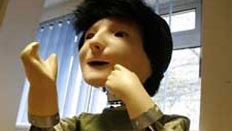Kaspar's journey
 Kaspar, the social robot, has been designed and developed by the University of Hertfordshire's Adaptive Systems Research Group, a leading international robotics research team.
Kaspar, the social robot, has been designed and developed by the University of Hertfordshire's Adaptive Systems Research Group, a leading international robotics research team.
Origins of Kaspar
In 1998, Professor Kerstin Dautenhahn and her team began developing and researching robots for use as therapeutic toys for children with autism who struggle to interact or communicate with the outside world.
Building on this early ground-breaking work, the Kaspar project was born in 2005. The vision: to create a social robot companion that would improve the lives of children with autism through play.
Amid mounting evidence that early intervention for children with autism has a significant impact on a child’s development trajectory, researchers set out to explore the extent to which interacting with Kaspar would help children with autism communicate more freely with other people.
Development of Kaspar
Previous studies in artificial intelligence and robotics had shown that a robot which looks too life-like can be unnerving. For this reason, the research team gave Kaspar a human-like but very simplified and child-friendly appearance.
Kaspar is the size of a small child and has a flesh-coloured face, but no facial hair or any additional details such as wrinkles. The robot has a neutral expression, not specific to any age or gender, so children can interpret Kaspar however they wish. To adults, Kaspar might not look pretty, but its realistic, human-like, yet simplified features very much appeal to children with autism.
Kaspar has gone through several iterations as researchers have refined their design in response to findings from field trials in schools and homes, using a 3D printer to create new parts.
There are 28 Kaspar prototypes in existence.
